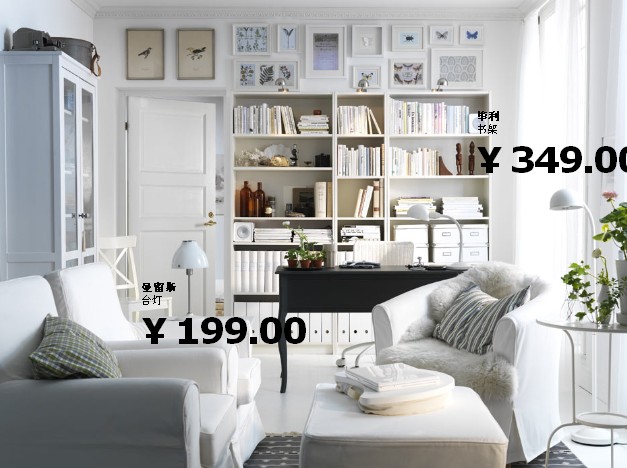It’s hard to be the bearer of bad news, but most of IKEA’s print and digital glam shots of picturesque rooms and products are – wait for it – fake.
虽然不想带来坏消息,但事实是,宜家的产品目录中那些展示房间布局和产品的美轮美奂的图片大多都是---合成的。
That’s right. Those beautiful, “natural-looking” photos of gorgeous rooms and kitchens are mostly the work of computer magic, toggled and tweaked until they’re picture-perfect.
没错,那些用来展示华丽房间和厨房的漂亮、看起来很自然的图片大多都是电脑合成的,它们通过电脑被不停地切换、调整直到变得完美为止。

Martin Enthed, IT manager for IKEA’s in-house communications agency, spoke to CGI Society earlier this year and revealed that a whopping 75 per cent of the furniture company’s product images today are generated by computers.
宜家内部广告部门的IT经理马丁•恩赛德今年年初的时候表示宜家约有75%的产品图片都是通过电脑合成的。
It’s a move that first caught the attention of photographers and graphic designers a few years back when the furniture giant announced it would scrap photoshoots in favour of computer-generated imagery (CGI).
几年前这个家具巨头就曾对外公布说公司会对照片进行拆解,这样只是为了生成CGI(电脑合成的图片),这份声明引起了不少摄影师和图形设计师的关注。
Enthed said IKEA began shifting gears in 2009 when company officials called in his team and said they weren’t pleased with a batch of photos and CG images.
恩赛德说宜家于2009年开始改变产品图片策略,当时公司的高管对他的团队说公司对某一批图片和CG图像很不满意。
“So we looked at all the images they said weren’t good and the two of three they said were great, and the ones they didn’t like were photography and the good ones were all CG, ” Enthed said. “Now we only talk about a good or bad image – not what technique created it.”
“我们查看了高管提出意见的所有图片,发现其中三分之二很不错,而且那些高管不喜欢的都是真实拍摄的照片,而他们认为好看的都是CG图片,”恩赛德说,“所以现在我们只管图片好不好看,不管使用什么技术。”
It’s a not-so-secret ruse used by top companies specializing in home and furniture design, though many consumers remain oblivious.
在顶尖的家居家具设计公司里这并不算是什么秘密,只是许多顾客被蒙在鼓里罢了。
“Most kitchen, bedroom and bathroom companies now use CGI to create their marketing material and no one has realized, ” said Pikcells creative director Richard Benson to Dezeen.
“在厨房、卧室和厕所产品等公司中,绝大多数会使用CGI图片展示产品,但这没人知道。”Pikcells 的创意总监理查德•本森说。
According to Enthed, the IKEA team plays with huge digital canvases measuring 4, 000 pixels x 4, 000 pixels for each image they render. Whether the image is of a Börje dining chair or of your dream Akurum/Lidingö kitchen, saving large files gives store designers the option to cover a wall with an image if they so please.
恩赛德称他们提交给宜家团队的每张图片都会在4000*4000的巨幅电子画布上进行修改。无论是Börje餐桌椅,还是你梦寐以求的Akurum/Lidingö厨房。大文件的好处是店面设计师可以将整面墙覆盖上设计图。
The company claims the shift is another way to reduce its environmental footprint, saying constructing digital files vs. building real sets produces less waste. It also helps the home furnishing empire's pocketbooks.
宜家公司声称此举是为了减少碳排放,他们表示用数字文件搭建场景比用实际产品产生的废料更少,对公司的效益也很有帮助。
“It’s a clever way to save money, ” IKEA head photographer Anneli Sjogren said in an interview with The Wall Street Journal in 2012.
宜家首席摄影师安内利•肖格伦2012年在接受《华尔街周刊》采访时说:“这是个省钱的好办法。”
That year, the furniture giant announced 12 per cent of its product and concept images would be CGI-rendered, increasing to 25 per cent in 2013. Since then, that percentage of rendered images appearing in the company’s catalogue and online has tripled.
2012年时宜家曾表示其12%的产品图片和概念展示图都是CGI渲染的,到了2013年这个比例提高到了25%。从那时起宜家产品目录和网上的图片经电脑合成的比例提高了两倍。
“We don’t have to throw away kitchens in the dumpster after the photo shoot, ” Sjogren explained at the time.
当时肖格伦解释说:“这样我们就不用在拍照之后把厨房扔进垃圾箱里了。”













